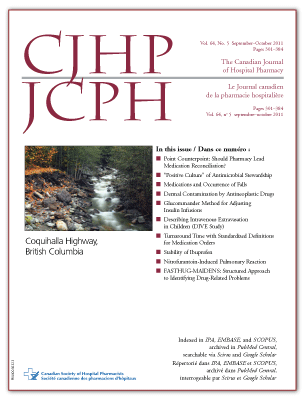Implementation of the Glucommander Method of Adjusting Insulin Infusions in Critically Ill Patients
DOI:
https://doi.org/10.4212/cjhp.v64i5.1068Keywords:
tight glycemic control, critically ill patients, régulation serrée de la glycémie, patients gravement maladesAbstract
ABSTRACT
Background: Intensive glycemic control has been associated with reduced morbidity and mortality in critically ill patients. Web-based, patientspecific insulin nomograms may facilitate improved glucose control.
Objective: To compare 2 algorithms for individualizing insulin infusion therapy (a web-based system [Glucommander method] and a standard paper-based nomogram) in a cardiovascular surgery intensive care unit (ICU).
Methods: In this prospective, before–after cohort study, measures of glycemic control for 50 patients receiving insulin according to the Glucommander system were compared with a control group (n = 50) who received insulin according to the standard paper-based nomogram used in the cardiovascular surgery ICU.
Results: There was no significant difference between the 2 groups with respect to time to target blood glucose (5.1–8.0 mmol/L), percentage of time within the target range, or mean amplitude of glucose excursion. Patients in the intervention group spent less time above the target range (p = 0.007) and more time below the target range (p < 0.001), and the mean glucose was lower in this group compared with the control group
(7.9 versus 8.6 mmol/L, p = 0.002). The percentage of blood glucose measurements below 4 mmol/L was higher in the intervention group than in the control group (3.7% versus 1.4%, p = 0.003). Satisfaction surveys revealed that the program was well accepted by the nursing staff in the cardiovascular surgery ICU.
Conclusions: A web-based insulin nomogram was an easy-to-use instrument for achieving tighter glucose control for patients in the cardiovascular surgery ICU. Use of the Glucommander system led to lower mean blood glucose but an increase in episodes of hypoglycemia.
RÉSUMÉ
Contexte : La régulation intensive de la glycémie a été associée à une réduction de la morbidité et de la mortalité chez les patients gravement malades. Des nomogrammes personnalisés d’ajustement posologique de l’insuline accessibles sur le Web pourraient faciliter la régulation de laglycémie.
Objectif : Comparer deux algorithmes de personnalisation de la perfusion d’insuline (nomogramme en ligne [méthode Glucommander] et nomogramme standard sur papier) dans une unité de soins intensifs (USI) chirurgicaux cardiovasculaires.
Méthodes : Dans cette étude prospective de cohortes avant-après, on a comparé les mesures de la régulation glycémique chez 50 patients dont le débit de perfusion d’insuline a été adapté au moyen du système Glucommander à ceux du groupe témoin (n = 50) qui ont reçu l’insuline selon le nomogramme standard sur papier, à l’USI chirurgicaux cardiovasculaires.
Résultats : On n’a observé aucune différence significative entre les deux groupes pour ce qui est du temps d’obtention des valeurs glycémiques cibles (5,1 à 8,0 mmol/L), du pourcentage de temps où la glycémie est demeurée dans la plage des valeurs cibles et de l’amplitude moyenne de la variation des valeurs de la glycémie. Dans le groupe Glucommander, la glycémie est demeurée moins longtemps au-dessus de la plage des valeurs cibles (p = 0,007) et plus longtemps au-dessous de la plage des valeurs cibles (p < 0,001), et sa valeur moyenne était moins élevée que dans le groupe témoin (7,9 contre 8,6 mmol/L, p = 0,002). Le pourcentage de mesures de la glycémie au-dessous de 4 mmol/L était plus élevé dans le groupe Glucommander que dans le groupe témoin (3,7 % contre 1,4 %, p = 0,003). Des sondages sur la satisfaction ont révélé que le programme était bien accepté par le personnel infirmier de l’USI chirurgicaux cardiovasculaires.
Conclusions : Le nomogramme en ligne était facile à utiliser pour obtenir une régulation plus serrée de la glycémie chez les patients de l’USI chirurgicaux cardiovasculaires. Le recours au système Glucommander s’est traduit par des valeurs glycémiques moyennes moins élevées, mais par une augmentation des épisodes d’hypoglycémie.
Downloads
Published
Issue
Section
License
Copyright © Canadian Society of Healthcare-Systems Pharmacy.
After publication of a manuscript in the CJHP, the authors of the manuscript must obtain written permission from the CSHP (publications@cshp.ca) before reproducing any text, figures, tables, or illustrations from the work in future works of their own. If a submitted manuscript is declined for publication in the CJHP, all said rights shall revert to the authors. Please note that any forms (e.g., preprinted orders and patient intake forms) used by a specific hospital or other health care facility and included as illustrative material with a manuscript are exempt from this copyright transfer. The CJHP will require a letter from the hospital or health care facility granting permission to publish the document(s).










